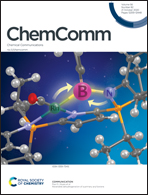Responsive fluorescent nucleotides serve as efficient substrates to probe terminal uridylyl transferase†
Abstract
We repurposed a terminal uridylyl transferase enzyme to site-specifically label RNA with microenvironment sensing fluorescent nucleotide mimics, which in turn provided direct read-outs to estimate the binding affinities of the enzyme to RNA and nucleotide substrates. This enzyme–probe system provides insights into the catalytic cycle, and can facilitate the development of discovery platforms to identify robust enzyme inhibitors.



 Please wait while we load your content...
Please wait while we load your content...